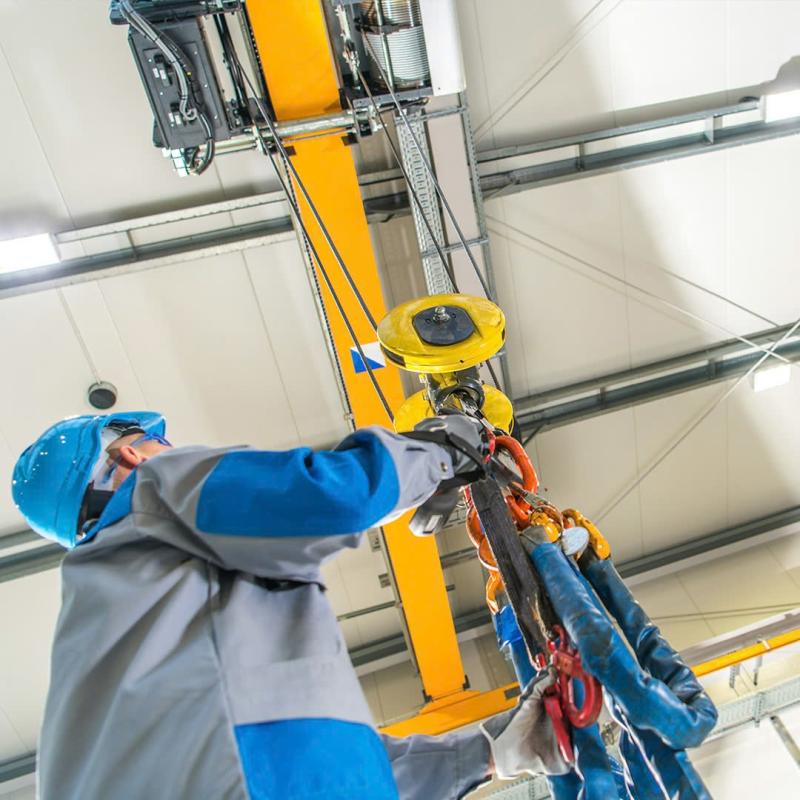



Among the many solutions available, jib cranes stand out as one of the most reliable and space-efficient lifting systems. Whether it's a freestanding jib crane for open-floor access, a wall mounted jib crane for fixed workstations, or an articulating jib crane for navigating complex layouts, understanding the right technical and purchasing factors is essential to maximizing value.
Explore The Efficiency of Jib Cranes to view full models from Aardwolf.
A jib crane is a type of crane with a horizontal jib or boom that supports a moveable hoist, typically mounted to a wall, column, or floor-mounted pillar. Its defining feature is the ability to rotate or pivot the boom, allowing for versatile load handling in a defined area.
Unlike overhead cranes that span large areas, jib cranes are designed for localized, repetitive lifting tasks. They are ideal for use in workshops, warehouses, manufacturing lines, and assembly cells.
Discover more in Jib Cranes Installations.
These cranes are floor-mounted and provide 360° rotation. They’re ideal for applications that require full-circle coverage and don’t rely on building structures for support.
Use Case – Aardwolf Client:
A Brisbane-based logistics center installed a freestanding jib crane with a custom 5m boom. It was used for repetitive pallet loading and unloading, allowing for a smoother packing line flow without structural modifications.
As the name suggests, these cranes are attached to existing structural walls and offer 180°–200° swing. They are excellent for workstations where floor space is limited.
Check out this real product: Installing wall-mounted jib cranes
Use Case – Aardwolf Client:
A metal fabrication shop in Victoria used Aardwolf’s wall-mounted model to lift sheet metal onto laser beds. The crane reduced manual handling injuries and cut production delays by 30%.
These are mounted directly onto the ceiling structure and free up valuable floor and wall space. They are especially useful in congested work zones.
Featuring two pivot arms, articulating jib cranes allow for flexible and intricate load movement. Perfect for navigating around obstacles or into machinery. Explore the jib cranes models
Use Case – Aardwolf Client:
An automotive parts manufacturer in Melbourne needed to load engine blocks into tight assemblies. The articulating crane provided the reach and dexterity they couldn’t achieve with fixed-arm cranes.
These are mounted to steel columns and offer stable, high-capacity lifting with a fixed rotation arc—ideal for dedicated zones like machining or tooling stations.
Your crane must handle the maximum weight of your lifting applications, with a safety margin. Aardwolf offers cranes from 125kg up to 1,000kg capacities.
Boom length determines reach. For example, a 4m boom is sufficient for small workstations, while longer booms suit pallet zones. Lifting height should accommodate not only the load but any obstructions along the path.
Freestanding and pillar cranes typically offer 360° rotation. Wall and ceiling-mounted cranes provide up to 200°, depending on the design.
Freestanding models need concrete foundation and anchoring.
Wall/ceiling mounted models require structural reinforcement and load assessment.
Articulating arms may need reinforced pivot points.
Jib cranes are often mistaken for gantry or overhead cranes. To understand their unique role, read: The difference between crane and jib cranes
Key Advantages of Jib Cranes:
Lower cost of installation
More compact
Easier integration into existing work cells
Reduced downtime and maintenance
Proper setup is crucial to safety and performance. Refer to this useful guide to apply jib cranes to ensure best practices are followed.
Assess mounting surface or foundation depth
Mark swing radius and boom travel area
Install base or anchor points
Mount hoist and test rotation
Perform initial load testing
Tip: For articulating models, ensure pivot joints are properly lubricated and structurally supported.
A granite shop used Aardwolf’s portable counterbalance jib crane to maneuver stone slabs across cutting, polishing, and finishing zones. No floor anchoring was needed, making it ideal for flexible workflows.
A facility in NSW used Aardwolf’s column-mounted jib crane to lift heavy molds into injection machines. With a defined radius of operation, they reduced mold changeover time by 40%.
| Requirement | Recommended Jib Crane Type |
|---|---|
| Space-constrained workstation | Wall mounted or ceiling mounted |
| High-mobility assembly zone | Articulating jib crane |
| Large swing coverage needed | Freestanding jib crane |
| Repetitive heavy lifting zone | Pillar mounted jib crane |
| Portable lifting solution | Manual counterbalance jib crane |
While jib cranes are low-maintenance, regular inspections improve safety and performance:
Bolts and anchor plates
Boom alignment
Hoist chain or wire tension
Grease pivot points
Inspect for wear on boom and trolley path
Check hoist brakes
Structural welds
Mounting integrity
Load test to full capacity
From product assembly to warehouse logistics, jib cranes serve as indispensable tools across industries. Their modular design, compact footprint, and precise movement make them ideal for repetitive, localized lifting tasks.
With a deep product lineup and proven case studies, Aardwolf offers reliable and innovative solutions tailored to your exact needs. Whether you're installing a new production line or upgrading your workshop, make sure to evaluate technical specs, mounting needs, and real-world applications.
Start your search with The Efficiency of Jib Cranes and explore practical examples in Jib Cranes Installations.
References
1. How to operate a Jib Cranes safely
3. Over brace jib crane wall mounted
5. Is a Jib Crane a Gantry Crane
6. Articulated Jib Crane Wall Mounted
8. Manual Counterbalance Crane
10. Over Braced Jib Crane Column Mounted
Sign up to receive the latest info on new Aardwolf products, special offers and more.
By signing up you agree to receive emails from Aardwolf with news, special offers, promotions and other information. You can unsubscribe at any time.